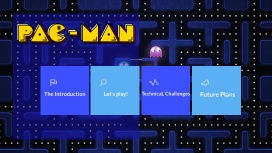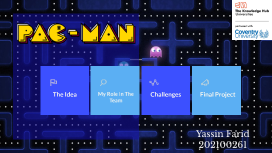PacMan AT3 Presentation
Transcript: GUI 2 Screenshots Game Page Start Page GUI 2 Screenshots Elements of an arcade style game Game Page Start Page Pac-Man exemplifies classic arcade-style gameplay through its engaging core loop, which involves navigating mazes, collecting pellets, and avoiding ghosts. The game features self-contained levels with progressively increasing difficulty, where each new maze introduces more complex layouts and faster ghosts. Controls are simple, using a joystick for easy navigation in four directions. Players are given a limited number of lives, adding urgency and challenge. High score tracking motivates players to improve their performance, while the game’s over-the-top elements, such as the dramatic effect of power pellets turning ghosts blue, enhance its lively atmosphere. Overall, Pac-Man integrates these elements to create a compelling and addictive experience. Functional requirents Functional requirements are important requirements in the development of the software. They indicate what a software system should do and also define the features or capabilities it should possess in order to satisfy the user's requirements and expectations. In most cases, these requirements are developed in a user-oriented way and fully describe the systems behaviour and functionality. 3 GUI's Screenshots Functional and non functional requirements CONTENTS Hardware in the 1980's In the 1980s, computers were exclusive to businesses and universities. Arcade gaming and Pacman gained popularity. Limited access to hardware and bulky computers with low processing power were the normality. With a few years of discovery, Microproccessors, CPUs and Hard drives helped in creating a better user experience. In more detail, Microprocessors helped lead the way in the development of new computers. This made computer to be produced in a easy and efficient way. CPUs allowed multitaksing and memory asddressing more quick by using processors, making it popular in buisnesses. Hard drives containing a large storage capacity, were durable and reliable to use. Introduction Comparing Hardware in the 1980s to the present time. Functional and Non-functional Requirements Understanding Ghost AI, Discussing the AI effect Pacman and its impact on the community Elements of an arcade style game 3 GUI's Screenshots Functional requirements define what a software system should do and what features or capabilities it should have. While Non-functional requirements define the quality attributes and performance standards for a software system. They describe how the software should operate, rather than what it should do. Introduction Introduction: Pacman is a ground breaking pastime that lent a huge impact to thenvideo game indsrty. This presentation will revolve around the differences between the hardware from the 1980s to the present and the consequences of these developments for the games available. It will also discuss the mechanisms of the movement that seems randomly moving ghosts and analyse the special features that build Pacmans perpetual attraction. The discursive terrain will treat Pacman as a main player in the video game sphere and analyse its inheritance as a model for the latest kinds of games. Non - Functional requirents Hardware in the 1980's Hardware in the Mordern Era Non-functional requirements play a critical role in the success and satisfaction of software systems. Have you ever interacted with software that was fast but frustrating? From defining response times that meet user expectations to implementing robust security measures that safeguard sensitive data, these requirements shape overall user experience. Failing to prioritize these elements can lead to high-functioning applications that fail to resonate with users. So, how can we elevate our products to not just meet, but surpass user aspirations? Today, computer hardware is miuch more powerful and effective than it was in the 80s. New processor units (CPUs) are now built with multi-core features that have been developed from the old days of single-core processors. Graphics cards have been developed to be extremely powerful and have real-time ray tracing capabilitis which are very advanced technology, while 1980s graphic cards were only able to display very basic graphics. At present gadgets are both compact, eco-friendly, and often lack wires but instead wireless communication; in contrast, 80s personal computers were very large and bulky and drew a lot of power from the electric grid and used networking cables. Portable, compact, and yet fast - this is the spirit of modern portable hardware. thinner, faster and more connective all over the device are the area where the major changes occured through time. GUI 1 Screenshots Game Page Start Page Functional and Non-functional Requirements Understanding Ghost AI, Discussing the AI effect The AI effect Understanding Pacman Ghost AI In Pac-Man, the AI effect is evident in how the ghosts' behavior, initially perceived as sophisticated, is now

















